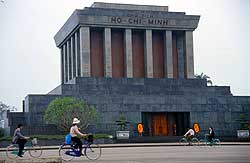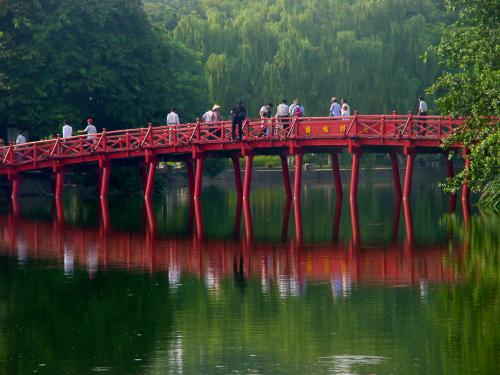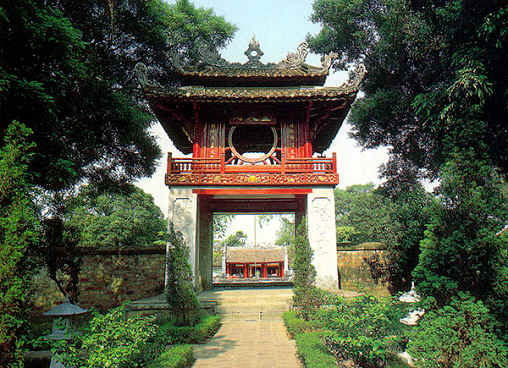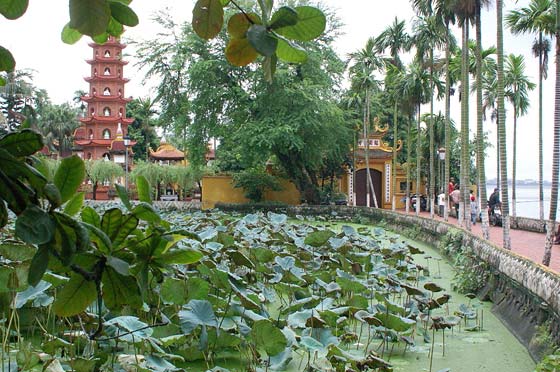|
 |
|
Ho Chi Minh 's Mausoleum
After two years of construction, the mausoleum of President Ho Chi Minh was officially inaugurated on August 29,1975. The facade of the mausoleum faces the historic Ba Dinh Square. The mausoleum is divided into three layers with a combined height of 21.6 meters. The lowest layer forms a terraced stand exclusively used for the presidium of grand meetings organized at the grassy Ba Dinh Square. The second layer is the central piece of the mausoleum where the remains of the president is kept in a chamber accessible through a series of passages and flights of marble staircases. The upper part of the mausoleum is the roof resembling a three terraced steps. The facade of the upper part bears an inscription "President Ho Chi Minh" made of dark violet precious stone. |
The mausoleum is the place to keep the remains of President Ho Chi Minh, the great patriotic who had been conferred the title "World Cultural Activist" and the national hero. The conferment was made on the occasion of the centenary anniversary of President Ho Chi Minh's Birthday (1890-1990). The mausoleum project was the results of artistic labor of both Vietnamese and former Soviet Union scientists in respect for President Ho Chi Minh.
Ho Chi Minh 's Residence
(Nha Bac Ho). After 1954 Ho Chi Minh had the run of the Presidential Palace, but the ostentation was too much for the ascetic president, who openly shunned luxury and preferred the humble former home of the palace's electrician, where he lived for four years. Then, the story goes, in 1958 Ho Chi Minh moved to this simple but tasteful wooden house on stilts, which served as his living quarters and work space until his death in 1969. An elegant but spare study -- some books, his small typewriter, a few newspapers, and an electric fan presented to him by a group of Japanese Communists are visible -- adjoins his equally spare bedroom. Downstairs he received his guests: foreign dignitaries, Politburo members, army cadres, and schoolchildren. Surrounding the house are well-tended gardens with flame trees, willows, mango trees. Cyprus trees thrive on the edge of the pond, which Ho had stocked with carp. A crisp clap of the hands apparently still brings the fish to the surface.
Regardless of Ho Chi Minh's faith in the accuracy of the city's antiaircraft gunners, some doubt must be thrown on the claim that Ho Chi Minh spent so much time in this open-air sanctum, with only the trees, his wooden house, and a trusty old war helmet as protection. American bombers targeted Hanoi during the war, and they surely would have emptied their loads on Ba Dinh District had they known their archenemy was feeding fish and conferring with his generals in the unprotected confines of his stilt house. Indeed, Ho's Politburo ordered the construction of a nearby bomb shelter, later dubbed House No. 67. Legend holds that Uncle Ho refused to use the shelter as a home, preferring to confer with the Politburo in this fortified bunker but to sleep in his stilt house. Before visiting Ho's residence, wait for the rest of the group that accompanied you through the mausoleum to go on ahead; it's much more enjoyable to walk through the jasmine-scented compound unhurried and without the inevitable chatter of other tourists. You'll exit this area via a pebbled pathway to the south of the mausoleum. As if they were themselves sights on the tour, older Vietnamese intellectuals wearing bifocals and striped cotton pajamas sit on park benches and read the Communist Party mouthpiece, Nhan Dan (The People), or sip green tea and smoke cigarettes. COST: 3,000d. OPEN: Daily 7:30-11 and 1:30-4.
One Pillar Pagoda
It is a group of structures consisting of a pagoda and a tower built in the middle of a square lake. The whole group was officially called Dien Huu Pagoda and Lien Hoa Tower, but the tower has traditionally been called the One-Pillar Pagoda. It is of a square shape and each side is nine feet long with a curved roof placed on a round stone pillar. The pillar is approximately 4 feet in diameter, twelve feet high (excluding the underground section) supporting a system of beams of timber, thus making up a framework for the tower resembling a blossoming lotus stretching up out of the square pond that has a surrounding brick wall. From the edge, there is a narrow brick path running through the pond to a nice ladder leading up into the Buddhist tower where there is a notice reading that the Lotus tower and pagoda were built in memory of a dream had by King Ly. The inscription states "King Ly Thai Tong (1028-1054) dreamt of seeing the Quan An Buddha sitting on a lotus tower to which the King was led. Upon waking, the King told his lords about his dream and sought their advice. Some of them advised him to build a stone pillar in the middle of the pond and place a Buddhist's lotus tower on the pillar just as the King had dreamt." Then Buddhist monks were asked to pray and worship for the King's longevity. Consequently, the pagoda was called "lasting life" (Dien Huu) and that took place in 1049.
The One-Pillar Pagoda has undergone numerous changes and repairs. On September 11, 1954 before their withdrawal, the French army mined and destroyed the Lien Hoa Dai. When the liberation forces took over Hanoi, the government rebuilt the pagoda in accordance with its original structure and completed it in April 1955.
Hanoi Old Quarter - Hanoi the 36 streets
As the oldest continuously developed area of Vietnam, Hanoi's Old Quarter has a history that spans 2,000 years and represents the eternal soul of the city. Located between the Lake of the Restored Sword, the Long Bien Bridge, a former city rampart, and a citadel wall, the Old Quarter started as a snake and alligator-infested swamp. It later evolved into a cluster of villages made up of houses on stilts, and was unified by Chinese administrators who built ramparts around their headquarters. The area was named "Dominated Annam" or "Protected South" by the Chinese. The Old Quarter began to acquire its reputation as a crafts area when the Vietnamese attained independence in the 11th century and King Ly Thai To built his palace there. In the early 13th century, the collection of tiny workshop villages which clustered around the palace walls evolved into craft cooperatives, or guilds. Skilled craftsmen migrated to the Quarter, and artisan guilds were formed by craftsmen originating from the same village and performing similar services. Members of the guilds worked and lived together, creating a cooperative system for transporting merchandise to the designated streets in the business quarter.
Because inhabitants of each street came from the same village, streets developed a homogeneous look. Commoners' homes evolved out of market stalls, before streets were formed. Because storekeepers were taxed according to the width of their storefront, storage and living space moved to the rear of the buildings. Consequently, the long and narrow buildings were called "tube houses." Typical measurements for such houses are 3 meters wide by 60 meters long. The Old Quarter has a rich religious heritage. When the craftsmen moved from outlying villages into the capital, they brought with them their religious practices. They transferred their temples, pagodas and communal houses to their new location. Each guild has one or two religious structures and honors its own patron saint or founder. Therefore, on each street in the Old Quarter there is at least one temple. Now, many of the old temples in the Old Quarter have been transformed into shops and living quarters, but some of the old buildings' religious roots can still be recognized by the architecture of their roofs. Although the old section of Hanoi is often called the "36 Old Streets," there are more than 36 actual streets. Some researchers believe that the number 36 came from the 15th century when there might have been 36 guild locations, which were workshop areas, not streets. When streets were later developed, the guild names were applied to the streets. Others attribute the 36 to a more abstract concept. The number nine in Asia represents the concept of "plenty." Nine times the four directions makes 36, which simply means "many." There are now more than 70 streets in the area.
Some streets have achieved fame by their inclusion in popular guidebooks. Han Gai Street offers silk clothing ready-made and tailored, embroidery, and silver products. Hang Quat, the street that formerly sold silk and feather fans, now stuns the visitor by its brilliantly colored funeral and festival flags and religious objects and clothing. To Thinh Street connects the above two and is still the wood turner's street. Hang Ma glimmers with shiny paper products, such as gift wrappings, wedding decorations and miniature paper objects to burn for the dead. Lan Ong Street is a sensual delight of textures and smells emanating from the sacks of herbal medicinal products: leaves, roots, barks, and powders.
Hanoi Opera House
(Nha Hat Lon). The centerpiece of French architecture in Hanoi and one of the grandest buildings in the city, the Hanoi Opera House is a small-scale version of the Paris Opéra designed by Charles Garnier and completed in 1875. The Hanoi structure, finished in 1911, incorporates the same grand elements of Napoleonic architectural style. Perhaps because of the theater's French history, its steps were the site of frequent denunciations against colonial rule. Immediately following World War II, in August 1945, Vietminh troops commandeered the Opera House and announced from its balcony the triumph of the August Revolution. Complete with an enhanced orchestra pit for 60 musicians and a movable stage, the 400-seat, three-tier theater hosts national celebrations, ballet, symphonies, pop and rock concerts, and opera. Seeing a show may be the only way to get into the Opera House, as its doors are usually closed.
 |
|
Hoan Kiem Lake(Lake of Restored Sword).
The lake which is not as large as Ho Tay to the northwest is situated in the center of the city. Because of its unique location Sword Restored Lake is billed as a basket of lower placed in the middle of Hanoi. The name of Sword Restored Lake is derived from a legend which has it that King Le Thai To had a precious sword. The sword. The sword had always been on his side during the 10-year resistance against the Ming aggressors. After he won over the foreign aggression and returned to Thang Long Citadel. One day he went out and boarded a royal boat to cruise in the lake. Suddenly he saw a giant turtle emerging and coming towards him. The king withdrew his sword and pinpointed with the sword the direction of the coming turtle for his soldiers' attention. |
All of a sudden, the turtle caught the sword between its teeth from the king's hand and submerged. The king thought that it might have been that during the resistance war against the Minh aggression, the king was offered sword by genie to help him defeat the enemy. Now when peace has returned the genie appeared and took back the sword. With that thought in mind, King Le Thai To named the lake after episode as Ho Hoan Kiem.
Ngoc Son Temple
Hoan Kiem lake which had been considered the most beautiful lake in the city was in the 19th century added with another object to make it more beautiful and famous. That was the construction of a temple on the Ngoc (Jade) islet in the lake. Initially the temple was called Ngoc Son Pagoda. Later it was renamed Ngoc Son Temple because in the temple is dedicated to saints. Saint Van Suong was a person considered the brightest star in Vietnam's literature and intellectual circles. Tran Hung Dao was worshipped because he was the national hero who led the Vietnamese people to a resounding victory over the Nguyen aggression. The temple as it is seen today was attributable to the restoration afforts of Nguyen Van Sieu in 1864. A great Hanoi literature writer, Nguyen Van Sieu himself had a large pen-shaped tower (Thap But) built in at the entrance to the temple. On the upper section of the Thap but there are three Chinese characters Ta Thanh Thien which means literally that to write on the blue sky is to imply the height of a genuine and righteous person's determination and will. Behind Thap But is Dai Nghien (Ink Stand). The ink stand is carved from stone resembling a peach, which is placed on the back of the three frogs on top of the gate to the temple. Passing through Dai Nghien visitors are to tread on the wooden bridge called The Huc. The Huc is literally understood as the place where beams of morning sunshine are touching.
On the long way that leads to the temple there are several cau doi (parallel sentences) written on the wall. These cau doi are considered part of a traditional ward puzzle entertainment, a lifestyle literally educated persons of ancient Thang Long used to follow.
 |
|
Temple of Literature - The first university of Vietnam
Location: Temple of Literature is located on Van Mieu Street, 2km west of Hoan Kiem Lake.Characteristics: Van Mieu - Quoc Tu Giam is a famous historical and cultural relic consisting of the Temple of Literature and Vietnam’s first university. The Temple of Literature was built in 1070 in honour of Confucius, his followers and Chu Van An, a moral figure in Vietnamese education.Quoc Tu Giam, or Vietnam's first university, was built in 1076. Throughout its hundreds of years of activity in the feudal, thousands of Vietnamese scholars graduated from this university. In 1483 Quoc Tu Giam was changed into Thai Hoc Vien (Higher Educational Institute). After decades of war and natural disasters, the former construction was completely destroyed. |
In preparation for the celebration of the 1000th anniversary of Thang Long (present day Hanoi) another construction has been built following the model of the previous Thai Hoc Vien on the same ground. The work includes the front hall, the back sanctuary, lean-tos on the left and on the right, the courtyard, and subsidiary structures.
This site preserves historical vestiges of a 1,000-year-old civilization such as statues of Confucius and his disciples (Yan Hui, Zengshen, Zisi, Mencius), and ancient constructions such as Khue Van Cac (Pavilion of the Constellation of Literature) and the Worshipping Hall.
Quan Thanh Temple
The three ancient Chinese which are still seen today on the top of the entrance to the temple means Tran Vu Quan. That is literally the temple which is dedicated to Saint Tran Vu. A temple is a place for worshipping saints while a pagoda is dedicated to Buddha and faithful disciplines.
Saint Tran Vu was a legendary figure which was a combination between a legendary character in Vietnam's legend and a mystic character derived from China's legend. The legendary character in Vietnam's legend was a saint who had earned the merits of assisting King An Duong Vuong in getting rid of ghost spirit during the King's construction of his citadel at Co Loa.
The Chinese legendary figure was a saint who made great contributions in safeguarding the northern border. Quan Thanh Temple was built during the reign of King Ly Thai To (1010-1028). In 1893 the temple was given a grand facelift to have the shape as we can see it today. Special attention should be paid to a black bronze statute of Saint Tran Vu. The giant statute, formally placed in the main hall, was cast in 1677. Another special object is an ancient bronze bell, 1.5 meters high, which is hanged at the top of the three-gate entrance.
Another object of no less significant is a smaller black bronze statute of Old Trong, a chief artisan of the bronze casting team who had made the giant statute of Saint Tran Vu and the great bell on top of the tree-gate entrance. To commemorate the great contributions of the teacher Old Trong, his students of bronze casting cast his statute and placed in the temple for their for their younger generations to remember Old Trong for ever.
Hoa Lo Prison - Hanoi Hilton
There's not much left of the infamous "Hanoi Hilton," the prison that once housed captured American servicemen during the Vietnam War, including U.S. Air Force pilot Douglas "Pete" Peterson, the first U.S. ambassador to Hanoi. What does remain, however, is a small section of the old prison, which is now a museum, and the tree under which Do Muoi, the aging former general secretary of the Communist Party, used to sit while writing on the backs of leaves during his imprisonment by the French in the years of Vietminh resistance.
Hoa Lo Prison Museum is a blunt reminder of the horrors of colonialism and wartime imprisonment. Here, through the front gates of the old French Maison Centrale (Central House, or Prison), built in 1896, you can get a handle on what life was like for Vietnamese prisoners held during France's occupation of Vietnam. (The number of prisoners under the French grew from 615 in 1913 to 2,000 in 1953.) In the southern hall, beyond the grisly guillotine and body basket, are cells where death row prisoners, including Hoang Van Thu, Tran Dan Ninh, and Nguyen Van Cu (who escaped and became a powerful early leader of modern Vietnam), were held. These cells are dank, dark, and anything but welcoming.
On exhibit upstairs are Vietnamese propaganda photos of American POWs, including Senator John McCain and former Ambassador Peterson, cheerily shooting pool, cooking, and writing letters. You won't be able to see the building where the American pilots were kept since it has been torn down, as has the cell from which Do Muoi and 100 other prisoners escaped in 1945 through the maze of sewers that ran under the prison, parts of which are on display in the courtyard.
If you're looking for historical detail about the prison, you may be disappointed by the museum's guidebooks, which are far more inclined to talk about the size of the cells than reveal any nuggets about what took place behind the musty yellow walls. Note, too, that there's little information in English at the museum. COST: 10,000d. OPEN: Tues.-Sun. 8:30-11:30 and 1:30-4:30.
Vietnam History Museum
Situated at # 1 Trang Tien Street, behind Hanoi's Municipal Theater, this museum was originally part of the Vien Dong Bac Co School that was founded in 1932 by the French. At that time, the museum exhibited a collection of ancient artifacts collected from all over southeast Asia.
In 1958, four years after the French lost control of Indochina, France gave the building to Vietnam and it became the national History Museum. Both floors of the museum house thousands of artifacts displayed in order of age, from ancient to contemporary. In the Stone Age section, you'll find tools and instruments for hunting and fighting made of polished stone, evidence of pre-historic ancestors living in present-day Vietnam. Included are stone axes chipped three to four hundred thousand years ago that were unearthed at Do Mountain in Thanh Hoa province, proof that the country is a cradle of civilization.
The Bronze Age section of the museum is famous for its bronze drums, the most notable of which is Ngoc Lu's majestic and beautiful drum which has been studied by scholars from all over the world for its implications on sculpture, its use and the manufacturing technology of its time. Also on exhibit are bronze axes, javelins, daggers, spears and other bronze weapons used for close range and distance fighting, weapons from the period of the Hung kings, during which Vietnam was first founded and Co Loa's 2nd century BC thin and thorny bronze arrows which so frightened northern invaders that they gained a reputation for being magical.
For the past 2,000 years, Vietnam's history has been a continuous struggle against foreign invaders. The museum's many photographs of pagodas, temples, fortresses, gravesites, famous figures and generals and many important documents, well known sayings and artifacts convey the indomitable will of the people.
Fine Arts Museum Hanoi
This is a national museum founded in June 1966. It displays art works and objects of the various nationalities living in Vietnam in every period. Prominent are collections of painting of great values by such famous contemporary artists as To Ngoc Van, Nguyen Phan Chanh, Tran Van Can and Bui Xuan Phai, etc,.
Address: 66 Nguyen Thai Hoc St, Hanoi. Tel: (84-4) 265801 or 233084
Museum Of Ethnology Hanoi Vietnam
Vietnam Museum of Ethnology is both a research centre and a public museum exhibiting the ethnic groups of Vietnam. The mission of the Museum is scientific research, collection, documentation, conservation, exhibition and preserving the cultural and historic patrimony of the nation’s different ethnic groups. The museum also serves to guide research, conservation, and technology that are specific to the work of an ethnographic museum.
In its planning for the future, the Museum intends to present the cultures and civilisations of other countries of South-East Asia as well as in the region.
 |
|
West Lake - Tay Ho Hanoi
This is a big lake in inner Hanoi covering an area of hundreds of hectares and the road around it is ten and a half miles long. Geographers have shown that the lake was once part of the Red River left behind when the river changed its course. It is perhaps due to changes in the courses of rivers and lakes that there are so many legends about them and their names. For instance, according to the "Ho Tinh" story, the lake was named after Xac Cao. The legend tells that there was a nine-tailed fox hiding itself in the area with the intention to harm the people. Long Quan raised the level of the water in order to destroy the fox's lair. The cave he occupied collapsed and was turned into the lake. |
According to another version, that of the "Bell Casting Giant," the lake had another name, "Golden Buffalo." This story tells of a giant amassing all the black bronze from the north in order to cast a bell which when struck, would echo throughout the countryside.
Because black bronze was the mother of gold, the north's golden buffalo heard the sound and desperately searched for its mother. It came to this area and repeatedly trampled upon it to such an extent that the earth sunk and it became a lake.
According to ancient manuscripts however, this lake was written into 11th century history as Dam Dam (Frost Lake) and by the 15th century, it was called Tay Ho (West Lake) and has long been a site of interest. Since the Ly-Tran dynasties, kings built various palaces around the lake as sites of interest and enjoyment.
When the lake and weather are calm, boating on it is a delight. On a walk around the lake, one can see many relics and sites of interest. Nghi Tam Village (birthplace of the famous poetess, Ba Huyen Thanh Quan), the Kim Lien pagoda with its unique architecture and Nhat Tan Village with its famous garden of peaches are located around the lake. There is also the Thien Nien pagoda dedicated to the founder of the art of weaving, Ke Buoi village with its traditional papermaking, Dong Co temple, and most striking of all, the Holy Mandarin Temple.
Today, with a series of newly built hotels around the lake, its beauty is even more diversified. Together with Truc Bach Lake, the West Lake further enriches the poetic nature of inner Hanoi while at the same time gives the city a source of fresh fish.